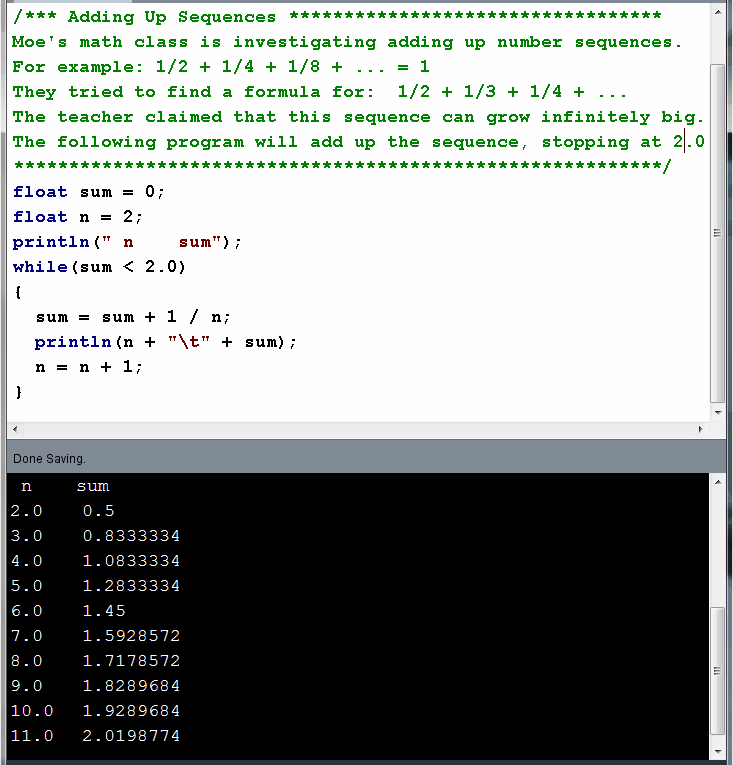Adding Up Sequences
Processing Code
Standard Java Code

Math Sequences and Computational Methods
Mathematicians study sequences of numbers. A sequence is a list of
numbers that follows a pattern.
Common examples are Arithmetic Sequences (adding the same number over and
over)
1 , 3 , 5 , 7 , 9 (always adding 2)
Total = 5/2(1+9) = 25
and Geometric Sequences (multiplying by the same number over and over).
1 , 2 , 4 , 8 , 16 , 32 (always
multiplying by 2)
Total = 2^6 - 1
Arithmetic and Geometric sequences are well understood by mathematicians.
They have simple formulas for adding up a lot of terms of the sequence.
This program adds up a sequence that is neither arithmetic nor
geometric. It adds up these fractions:
1/2 + 1/3 + 1/4 + 1/5 + 1/6 + 1/7 + 1/8 + 1/9 +
1/10 + 1/11
Total = approximately 2.02, but there is no exact
formula
A non-standard sequence like this does not have a nice simple formula for
adding it up.
The best way to get a result is to use a computational method - that is, a computer program
that follows rules and calculates the total by normal calculations.
Computational methods are not
perfectly accurate, because computers do not do perfect calculations.
Computers must round-off or truncate results so that they can be
stored in memory.
The tiny errors are unacceptable to mathematicians, but scientists and
engineers are satisfied with approximate answers.
Although computation produces slight inaccuracies, they have the advantage
that complex rules
can be programmed reasonably easily, so some useful results can be obtained
without difficult mathematics.
Even if there is an exact mathematical formula, it is often easier to write
a computer program.
Practice
- Download the program and run it.
- Change the program so that it runs until the total is greater than
10.0 .
- Change the program to add up the following numbers:
1 + 4 + 9 + 16 + ... + 19^2 + 20^2
- Change the program to add up the following numbers:
1/1 + 1/4 + 1/9 + 1/16 +.... + 1/(19^2) + 1/(20^2)
- Change the program to add up the following numbers:
1 + 3 + 5 + 7 + 9 + .... + 99
- Add up 1+3+5+7.... until the total is greater than 1 million
- Add up 1+3+5+7 ... until the total is greater than 1 billion (1 000
000 000)
- Add up 1+3+5+7 ... until the total is greater than 1 trillion (1 000
000 000 000)
- Try to recognize a pattern in these totals.

